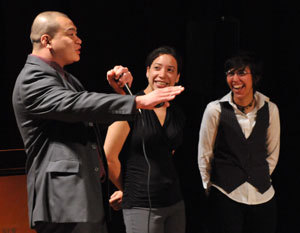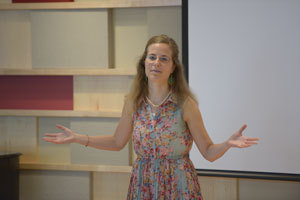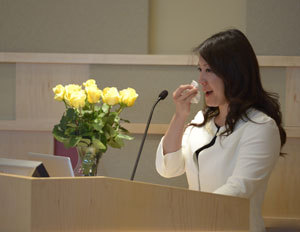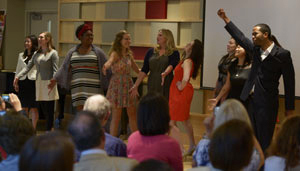How to Be Successful Using Great Communication Skills
 I have often found it’s the small asides at meetings, gatherings, or discussions that contain some of the richest nuggets of information. It’s rather like footnotes in a novel that take the reader exploring some new pathway of thoughts. Just a few years ago at a class I was giving as part of our Sistema Fellows program, one of my very favorite people, Lorrie Heagie (in photo right), who is heading a stunning Sistema-inspired initiative in Juneau, Alaska, suddenly threw in a comment which seemed to land and disappear in the class, but which conversely resonated with me for days. So much so, in fact, that I quietly began a study of the subject. She said very simply, “Well, of course, it’s all about effective story telling.” Why did this mean so much to me? What was so profound in those few words? And how could storytelling be so effective.
I have often found it’s the small asides at meetings, gatherings, or discussions that contain some of the richest nuggets of information. It’s rather like footnotes in a novel that take the reader exploring some new pathway of thoughts. Just a few years ago at a class I was giving as part of our Sistema Fellows program, one of my very favorite people, Lorrie Heagie (in photo right), who is heading a stunning Sistema-inspired initiative in Juneau, Alaska, suddenly threw in a comment which seemed to land and disappear in the class, but which conversely resonated with me for days. So much so, in fact, that I quietly began a study of the subject. She said very simply, “Well, of course, it’s all about effective story telling.” Why did this mean so much to me? What was so profound in those few words? And how could storytelling be so effective.
Storytelling is an essential part of every culture. People are always eager to hear or relate a story whether from a book, a film, a play, a remembrance from childhood or a recent vacation. We are all full of stories and they are central to our understanding of the world along with the vast body of myth, legend, fables, folk stories, plays, mysteries and the great parables of the Bible, the Koran, the Torah. Stories are not ever lectures or long dissertations, although they may have didactic or moral implications. Instead they transform ideas into something totally emotional, vibrant, and energized, which then have the power to engage our imaginations. I see stories as part of our collective consciousness, a palace of knowledge, beliefs, values, attitudes, passions, dreams, vision, hopes, fears and understanding. They touch at the center of our humanity and as such are incredibly powerful. Effective storytelling will always make the chronicler memorable and understood and will establish his warmth of personality, originality, uniqueness, and authenticity.
 For young musicians to have storytelling as part of their portfolio of skills will give them an edge (I will elaborate on this in my post script) in our incredibly competitive world. I suppose you could call it “presentation skills,” or “good communication,” but I like to stay with “storytelling” because I believe this rubric encompasses its power. Musicians or artists skilled in storytelling, that is, telling the story of their passion for music and discovery will be incredibly successful in communicating with an audience, introducing a new work, sitting with a donor and telling the story of why a creative idea needs financial investment, or just plain selling themselves for the next gig or concert series. This edge will allow them a competitive advantage which will lead to work and repeat invitations!! (In photo above, members of the Class of 2011 Sistema Fellows at NEC).
For young musicians to have storytelling as part of their portfolio of skills will give them an edge (I will elaborate on this in my post script) in our incredibly competitive world. I suppose you could call it “presentation skills,” or “good communication,” but I like to stay with “storytelling” because I believe this rubric encompasses its power. Musicians or artists skilled in storytelling, that is, telling the story of their passion for music and discovery will be incredibly successful in communicating with an audience, introducing a new work, sitting with a donor and telling the story of why a creative idea needs financial investment, or just plain selling themselves for the next gig or concert series. This edge will allow them a competitive advantage which will lead to work and repeat invitations!! (In photo above, members of the Class of 2011 Sistema Fellows at NEC).
So how on earth do you go about acquiring this skill? Well… I would suggest that it’s about structure and delivery, which I see as actually connected. Structure is all about the mechanics of putting ideas into a compelling and coherent whole, and delivery is the performance aspect, how you actually tell that story to an audience, and the many techniques you can use to engage those listeners.
To begin with, let’s start with some structure by establishing Intent because this will propel the story and give it foundation. If you are not intentional in life then structure and the advantages it provides will fly by you. Intent is the sum of motive and goal and the distinctiveness of both. Take a sample line: “He was so passionate about the Beethoven sonata he wanted to play it for everyone.” There’s a clear motive, his passion for Beethoven, and an equally clear goal, playing it for everyone. Ask yourself these two simple questions on motive and goal the next time you begin a project or prepare a presentation, and you will have begun the first discipline of storytelling structure. You are the protagonist of your story. It is your story and you are totally invested in it. So be conscious and curious about how you communicate that story. (In video below, NEC violinist Robyn Bollinger expresses her passion for the Paganini Caprices and sets them in historical context.)
Your eyes are the most important part of your engagement with an audience. As the poet said “they are the windows into your soul,” and people will be making intuitive judgments about what they see reflected in your eyes. So, keep your eyes connected to your audience. Let them experience the essence of you. No burrowing your head in your notes, or looking at your shoes.
Use your voice, just as a singer or great actor does. Everyone has at least six notes in their voice which can be used for effect, for emphasis, for drama, or color. There is nothing worse than a colorless monotone. You should video yourself to see exactly how you look and sound. It is one of the most painful but also one of the most effective things you can do. Once you have become conscious of your voice and how you use it, experiment with color–from soft sounds to hard, even abrasive, sounds–and then focus on projection, making certain that your voice can be heard, across a room or across a large hall. That’s the objective, after all.
 After your eyes and voice, the next thing the audience will notice is your body language. Are there areas of tension? How are you using your hands and arms, which, all too often become, unrelated to the rest of you, appendages you had never noticed before? Use movement–walk around in front of your audience in a small imagined “garden” of your design, if this helps to relieve tension. Arms and hands can be used as emphatic props, so practice throwing them around to emphasize points. Practice relaxation so that tension never appears before your audience. (Here Tatjana Merzyn, Class of 2014 Sistema Fellow, makes a point.)
After your eyes and voice, the next thing the audience will notice is your body language. Are there areas of tension? How are you using your hands and arms, which, all too often become, unrelated to the rest of you, appendages you had never noticed before? Use movement–walk around in front of your audience in a small imagined “garden” of your design, if this helps to relieve tension. Arms and hands can be used as emphatic props, so practice throwing them around to emphasize points. Practice relaxation so that tension never appears before your audience. (Here Tatjana Merzyn, Class of 2014 Sistema Fellow, makes a point.)
Engage your audience with energy. How many performances have we all experienced where the performer is just phoning it in? No contact, no engagement with the audience, and no sense that the audience is the most important group in their lives at that very moment. Be in the moment with so much energy that you will be exhausted at the end of it all. And that’s great!
Use dissonance to get everyone’s attention. And by dissonance I mean an idea or an image that grabs an audience’s attention. Here are some opening sentences from some famous books that do just that, compelling you to read on because your attention is caught:
“Many years later, as he faced the firing squad, Col. Aureliano Buendia was to remember that distant afternoon when his father took him to discover ice.” – Gabriel García Márquez, 100 Years of Solitude
Or
“The sky above the port was the color of television, tuned to a dead channel.” -William Gibson, Neuromancer.
Or
“Jack Torrence thought: Officious little prick.”– Stephen King, The Shining
These are some really effective examples of dissonance and its attention-grabbing power.
Work on the use of metaphor. It is, after all, how we try to explain the world around us. You might simply use a metaphor to create an image of your experience of something. “He’s a rock star” or “Life’s a balloon.” It adds so much color. Here are some examples from Shakespeare, whose genius with metaphor knows no bounds. I use Shakespeare not that you need to emulate him (if that were possible) but as examples of the energy in a well- tuned phrase and image:
“Love looks not with the eyes but
With the mind,
And therefore is winged Cupid painted blind.”
Or
“Love is a smoke and is made with the fumes of sighs.”
Or
“Life’s but a walking shadow, a poor player,
That struts and frets his hour upon the stage,
And then is heard no more. It is a tale told by an idiot, full of sound and fury,
Signifying nothing.”
A well-tuned phrase creates strong impressions and it is worthwhile finding time to think just a bit poetically because it will be that which stages in the audience’s mind.
Which leads me to memorability. How do you do or say anything that could be experienced as memorable? Think about works of music, art, or literature that you can bring instantly to mind. What are their characteristics? How do they command such attention in our minds and memories?
Spending time and creative thought in honing your storytelling to incorporate some of the techniques I am outlining will take you a long way towards this. What you want is an experience that I had in my life recently, when someone came up to me and said that they heard me talk six years prior, how much it meant to them, and then started to quote me!! Now that’s engagement and memorability.
Add detail to your story. It creates a stronger image and adds a sense of authenticity that will connect with your audience, as it provides that patina of mental reality. Detail can seem a throw away, something added almost as an aside, but the thought and preparation that go into producing detail is serious stuff. Just think back to that very first Star Wars movie, Episode 4, from the 1970’s. I am sure we all have seen the movie a million times and I rank it as one of the most magical and memorable of all time. Here are two scenes that come to mind immediately. Obi-Wan takes Luke, R2-D2 and C-3PO to that “den of iniquity” to find Han Solo. They walk into what must pass as a bar but it is populated by the strangest creatures from all parts of the galaxy, with a band playing in the background on instruments that are equally strange. Or the scene on the Millennium Falcon when C-3PO is playing a hologram board game with Chewbacca and the pieces are actually alive and moving! None of these scenes move the story on or are necessary to the plot but…they add that authentic note to the story. You don’t have to be George Lucas in terms of invention, just conscious of the moments of detail that make a difference to your story.
 Use emotion in your storytelling in an authentic way. If an experience meant something to you then let the audience feel that. If you find relating the experience difficult and emotional, that’s good too. Find ways to bring that authentic voice to your audience. (In photo, Sistema Fellow Eriel Huang from Class of 2014 tears up at graduation presentation.)
Use emotion in your storytelling in an authentic way. If an experience meant something to you then let the audience feel that. If you find relating the experience difficult and emotional, that’s good too. Find ways to bring that authentic voice to your audience. (In photo, Sistema Fellow Eriel Huang from Class of 2014 tears up at graduation presentation.)
Work on simplicity. Being simple requires great thought and energy. That old adage “I am sorry my letter is so long but I didn’t have time to write a brief one,” has never been truer. Simplicity comes from the great discipline of making your message totally clear. If there are three things you want the audience to know, then how do you go about making those three things have the most clarity and simplicity so that the audience gets it, and remembers? Those three things are what you have identified as the absolute centre of your story, what it is about. It might be your passion for music, the historical context of a work and its composer, or the significance it has played in your life. But be intentional. Prepare and then deliver what is important to your story. Be painfully honest about eradicating redundancy. Clear away the rubbish to identify the shining ideas that you want to have heard but still keep the detail!
Use Silence when you speak. This is probably one of the most difficult things for anyone to do these days as we are constantly intent upon filling every space with some form of sound or noise. But silence can be used to provide emphasis and create oxygen around an idea.
And together with silence comes pacing and rhythm. Establish the pace of your storytelling based upon your intuitive and visceral response to your audience. You are not there to stand and deliver, you are there to pro-actively react to the needs and experience of the audience. So try using rhythm to help with pacing and vary this in order to provide color and emphasis.
 Use humor. Humor is one of the greatest ways of allowing an audience to get to know you and trust you. Self-effacing humor is particularly effective, but using humor through your storytelling will ensure that you have a light touch and have charmed your audience. You don’t have to demonstrate the brilliance of a Robin Williams, you are not doing stand-up, but we can all use the positive parts of our characters to infect those little moments where an audience smiles with you. (The 2014 Class of Sistema Fellows in a humorous presentation.)
Use humor. Humor is one of the greatest ways of allowing an audience to get to know you and trust you. Self-effacing humor is particularly effective, but using humor through your storytelling will ensure that you have a light touch and have charmed your audience. You don’t have to demonstrate the brilliance of a Robin Williams, you are not doing stand-up, but we can all use the positive parts of our characters to infect those little moments where an audience smiles with you. (The 2014 Class of Sistema Fellows in a humorous presentation.)
There are lots of other refinements we could take a look at but I think the most important part of it all may be the audience. Find out as much as you can about them, who they are, where they come from, the demographics. Not the full FBI research but enough for you not to be surprised. Remember that an audience will come and see you out of curiosity and a wish to be entertained, and maybe even a desire to have something transformational and uplifting from the music you are about to perform. The audience will come as themselves, with all their lives, their problems, perceptions, histories, loves, prejudices. They are human beings after all. And they will use all of this to color in everything that you say and do.
Ending! Endings are the most difficult thing to structure in stories and in life. Saying goodbye, ending a relationship, are protracted and messy. Beethoven had the worst time in trying to end some of his works. The tonic, dominant chords seem to go on for an age. Only Haydn truly has the ending technique totally mastered. Just listen to his set of six String Quartets, Op. 76 for some of his finest examples. But when you want to end a story, that final part of your communication, what do you do? You must end with all the energy and commitment with which you began. Never go into terminal decrescendo. You should summarize and include one new element with the intention of ending in glorious D-Major. Just listen to the last movement of Mahler’s Symphony No. 1, for a great example.
To illustrate such an ending is the shortest novel ever written. It’s just six words long and purportedly comes from Hemingway. It demonstrates a profound use of words and images which gives to us its audience the power to create a whole story prior to those six words, and a whole story after them.
“For sale, Baby shoes, never worn.”
Not D-Major I know, but such a great d-minor.
P.S. Actually, here is a D-Major ending…sort of. I want to define “having an edge,” a competitive advantage, which I mentioned at the beginning. I will define this by way of a simple equation…creativity + order = a target score of 20, with 10 as the maximum per side. Creativity is what a young artist is devoted to, developing his musicianship, refining technique, working on interpretation. Order is the non-musical part of being a musician but so important in this Darwinian world of career competition. It incorporates networking, building a website, having a career plan, marketing, programming, cultivating leadership skills, practicing time management, sharpening presentational skills (storytelling!). Now rate yourself on a scale of 10 for each part–creativity and order. Most people I know give themselves high marks for creativity, but they stumble over order with a low rating. One might have a creativity rating of nine, but a low of four for order, resulting in a total of 13, towards the goal of 20. And it’s the remaining seven that gives you the edge. But if you want to refine order down to what I consider the absolute essentials, then I would focus on networking and storytelling. The rest will follow because you’ll be very successful. Now would Mahler be pleased with this ending??! I hope so.
P.P.S. I want to recommend a book that Lorrie Heagie gave me on this subject. Story Proof: The Science Behind the Startling Power of Story by Kendall Haven. It really changed my thinking.
Note: This material was excerpted from a class given as part of New England Conservatory’s Entrepreneurial Musicianship program in September 2014 called “Tony’s Talks.”

Leave a Comment: